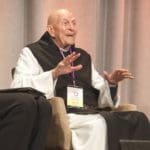Should We Sit Quietly During Prayer?
Part I of III
 Today I want to begin discussing misconceptions about the place of silence in prayer growth. Since we desire contemplation, should we sit still in prayer and wait for it? Should we try to make it happen by quieting our minds? This three-part series speaks to the differences between Carmelite teaching and Centering Prayer, yoga, and other types of meditation influenced by eastern religions.
Today I want to begin discussing misconceptions about the place of silence in prayer growth. Since we desire contemplation, should we sit still in prayer and wait for it? Should we try to make it happen by quieting our minds? This three-part series speaks to the differences between Carmelite teaching and Centering Prayer, yoga, and other types of meditation influenced by eastern religions.
Some people falsely equate silence with supernatural (infused) contemplation. They read about the need for interior silence in prayer, and they mistakenly think that if they sit quietly, God will necessarily bestow contemplation upon them. They equate the peace they find in silence to communion with God.
 In 1989, Cardinal Joseph Ratzinger (later Pope Benedict XVI), as head of the Congregation for the Doctrine of the Faith (CDF), wrote Letter to the Bishops of the Catholic Church on Some Aspects of Christian Meditation. Here is what the document says about silence:
In 1989, Cardinal Joseph Ratzinger (later Pope Benedict XVI), as head of the Congregation for the Doctrine of the Faith (CDF), wrote Letter to the Bishops of the Catholic Church on Some Aspects of Christian Meditation. Here is what the document says about silence:
“[Some] methods of meditation… including those which have their starting-point in the words and deeds of Jesus, try as far as possible to put aside everything that is worldly, sense perceptible or conceptually limited. It is thus an attempt to ascend to or immerse oneself in the sphere of the divine, which, as such, is neither terrestrial, sense-perceptible nor capable of conceptualization.” (paragraph 11)
What does that mean? The CDF criticizes meditation methods that seek to avoid normal sense perceptions and concepts, even if these methods use words from the Gospel. Such methods promote a false type of silence. Quieting all thoughts and going beyond concepts by one’s efforts does not bring about contemplation.
“The meditation of the Christian in prayer seeks to grasp the depths of the divine in the salvific works of God in Christ, the Incarnate Word, and in the gift of his Spirit. These divine depths are always revealed to him through the human-earthly dimension.” (Ibid.)
In other words, true Christian meditation uses the mind. It ponders the work of God, especially in the Incarnation.
One of the perennial heresies is Gnosticism, which devalues the material world. In some forms it rejects even human thoughts and concepts. In contrast, the Catholic Church teaches that creation is good, although fallen. God became a Man. He redeemed creation. Pondering God’s work in Christ is a valuable way to get to know His character and learn to love Him. It inspires us to give up sin and attachments to worldly things. We practice asceticism, not because creation is evil, but because God is so much greater than His creation. He should always be our focus.
 Proponents of Centering Prayer insist the CDF was talking about other methods of prayer, that it was not criticizing their movement. I think even a quick reading of the document makes it clear that the Vatican was criticizing Centering Prayer. Fr. Thomas Keating, Trappist monk and one of the leading proponents of Centering Prayer, wrote a response to the CDF document. I find his defense of Centering Prayer to be completely unconvincing, when compared with the actual method and teaching of Centering Prayer. Here is the basic Centering Prayer method, from a document called The Method of Centering Prayer by Thomas Keating (do not try this at home!):
Proponents of Centering Prayer insist the CDF was talking about other methods of prayer, that it was not criticizing their movement. I think even a quick reading of the document makes it clear that the Vatican was criticizing Centering Prayer. Fr. Thomas Keating, Trappist monk and one of the leading proponents of Centering Prayer, wrote a response to the CDF document. I find his defense of Centering Prayer to be completely unconvincing, when compared with the actual method and teaching of Centering Prayer. Here is the basic Centering Prayer method, from a document called The Method of Centering Prayer by Thomas Keating (do not try this at home!):
“1. Choose a sacred word as a symbol of your intention to consent to God’s presence and action within.
“2. Sitting silently and with eyes closed, settle briefly and silently introduce the sacred word as a symbol of your consent to God’s presence and action within.
“3. When you become aware of thoughts, return ever-so-gently to the sacred word.
“4. At the end of the prayer period, remain in silence with eyes closed for a couple of minutes.”
Now, someone who is practiced in prayer and the virtues might be able to take this outline and make it into legitimate Christian prayer. But in and of itself it has many problems.
The first thing to note is that Fr. Keating here presents Centering Prayer as a method, although elsewhere he protests that it is not a method at all. This is typical of writings by Centering Prayer advocates. They repeatedly contradict themselves, making it difficult to know exactly what they are proposing.
Centering Prayer makes attention to the “sacred word” primary. This word can be Jesus, but also impersonal nouns such as love, mercy, joy, peace, etc. Thoughts become the enemy of the chosen word, and thus the enemy of prayer.
The Holy Trinity, and especially Jesus, should always be the focus of our prayer time. Not just Jesus’ name, but Jesus Himself. Prayer should never be impersonal. If we don’t commune with our Lord, we are not praying! Whom are we addressing when we repeat the word peace, for example? It’s not clear to me that we are addressing anyone. Where is the conversation in this method? How is it relational?
 The peace that one feels when repeating a word is not contemplation, nor is it supernatural. Any word will produce the same results. These are natural phenomena. Practitioners of Transcendental Meditation do the same thing and produce the same results with different words. Repeating a sacred word or mantra to the exclusion of all other thoughts and feelings is a form of self-hypnosis. It can never produce contemplation, because contemplation is a supernatural gift.
The peace that one feels when repeating a word is not contemplation, nor is it supernatural. Any word will produce the same results. These are natural phenomena. Practitioners of Transcendental Meditation do the same thing and produce the same results with different words. Repeating a sacred word or mantra to the exclusion of all other thoughts and feelings is a form of self-hypnosis. It can never produce contemplation, because contemplation is a supernatural gift.
Step 4 of Keating’s method is typical of hypnosis. The person who has been hypnotized has to be brought back slowly to normal life. In contrast, traditional Christian meditation ends with praise or thanksgiving. There is no need to sit in silence after the conversation ends.
 Like Centering Prayer, yoga uses natural techniques to quiet the mind and bring on a peaceful state that has nothing to do with closeness to God or communicating with Him. Here are steps 3 and 4 from an online article on yoga called 5 Steps to Meditate Anywhere. This is yoga adapted for use throughout the day. Notice how these points address the same issues as Keating’s Centering Prayer:
Like Centering Prayer, yoga uses natural techniques to quiet the mind and bring on a peaceful state that has nothing to do with closeness to God or communicating with Him. Here are steps 3 and 4 from an online article on yoga called 5 Steps to Meditate Anywhere. This is yoga adapted for use throughout the day. Notice how these points address the same issues as Keating’s Centering Prayer:
“3. Meditate with purpose. It seems ironic, but meditation is a very active process. The art of focusing your attention on a single point is difficult, and it really helps the process to be purposefully engaged with what you are doing. Although there’s no need for repetitive mantras or forceful objectives, it is nice to have a positive intention for each day (even if it’s ‘I really need to relax on this vacation.’)
“4. Watch your attention. Your biggest block to meditation is yourself or, more specifically, your mind. This is great news for success because you can control your mind. If you notice yourself getting caught up in a train of thought that pulls you strongly from the present moment, simply bring your attention back to your breath. This truly gets easier with practice.”
Again, the point is to actively focus one’s mind on one thing, and get rid of all other thoughts. This is not prayer. This is concentration through natural means.
The CDF seems to be speaking specifically about yoga when it says:
“Some physical exercises automatically produce a feeling of quiet and relaxation, pleasing sensations, perhaps even phenomena of light and of warmth, which resemble spiritual well-being. To take such feelings for the authentic consolations of the Holy Spirit would be a totally erroneous way of conceiving the spiritual life. Giving them a symbolic significance typical of the mystical experience, when the moral condition of the person concerned does not correspond to such an experience, would represent a kind of mental schizophrenia which could also lead to psychic disturbance and, at times, to moral deviations.” (paragraph 28)
Quieting the mind in order to concentrate more fully on God is a good thing. But the key is the second phrase: to concentrate more fully on God. Yoga and Centering Prayer make the concentration and the feelings it produces the end, instead of the means. They see these peaceful feeling as supernatural, when they are completely natural.
Two kinds of quiet should be included in every authentic Christian prayer:
- Setting aside a time and place where we can be alone with God with few distractions is one of them. This doesn’t require any technique.
- The second, which Centering Prayer completely ignores, is detachment from sin and from everything that is not God. In concentrating on a repeated word to the exclusion of all else, Centering Prayer actually promotes attachment to things other than God. The mantra becomes an idol. This is not Christian prayer.
In Part II, we’ll examine what Teresa of Avila taught about silence in prayer, and how and when she teaches us to practice it.
Art: Santa en oración (Saint in prayer), Joaquín Sorolla, 1888, PD, Wikimedia Commons. Pope Benedict XVI, Dan Burke file copy. Detail from Thomas Keating, discussion with the Dalai Lama Boston 2012, “christopher”, 14 October 2012, CCA; The Holy Trinity, miniature from the Grandes Heures [Great Hours] of Anne of Brittany, Queen consort of France (1477-1514). f. 155v. God the Father on left, Jesus on right, holding book with seven seals open to Alpha and Omega passage, dove of Holy Spirit in center, “animal” symbols of Four Evangelists in corners, Jean Bourdichon, 1503-1508, PD-US; Detail from Tony Nader, AKA Raja Ram, leader of the Global Country of World Peace and the Transcendental Meditation movement, Keithbob, 14 July 2010, PD-Worldwide; Yoga Meditation Position, Cornelius383, own work, 25 April 2012, CC; all Wikimedia Commons.




